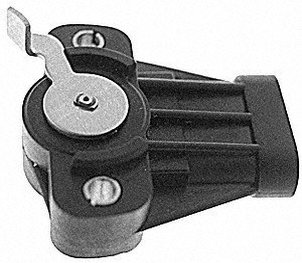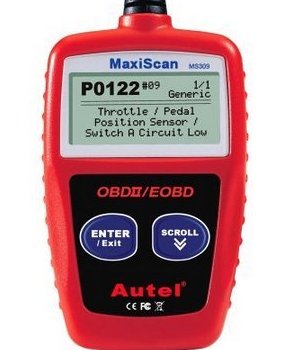
The throttle position sensor is another computer sensor that’s often misdiagnosed. Popular replacement TPS parts are available at the bottom of this page, but please test your old one before replacing it.
What should you do if you find a TPS code set in the computer’s memory? Both professional and DIY auto mechanics will often replace the component just because the code set.
As I have learned in the school of hard knocks, just because a sensor sets a code doesn’t mean the part has failed. It may be trying to tell you the truth and other related wiring problems could actually be causing the malfunction. When I see a voltage high or low code I often find a damaged connector or wires between the throttle body and PCM.
What is a Throttle Position Sensor
The TPS is a potentiometer type of electrical component. Rather than just being opened or closed like a switch, it controls the circuit by varying its resistance in response to throttle position.
In most cases this variable resistor will send a very low voltage back to the main computer when the throttle plates are fully closed. This reference voltage rises as the throttle opens to increase speed.
Keep in mind that some manufacturers use inverse voltage readings for feedback. A bad part can cause many problems in overall performance. Inaccurate data can cause transmission problems as well. Some transmission problems can be related to TPS sensor malfunction.
As an example, no up shifting, fast up shifts, late or delayed shifts, and line pressure problems that control internal solenoids and torque converter clutch engagement. Engine related problems can include a tip in or hesitation when cracking the throttle.
Testing for TPS Problems
You can test a throttle position sensor with an automotive scan tool. This is probably the easiest and most cost-effective way to diagnose a problems with this system.
Although the scan tool will have to be capable of displaying the data stream. Some of the cheaper scan tools only read and erase check engine light codes.
The value can be analyzed on the scan tool and the throttle slowly depressed looking for either increase or decrease in voltage. Any dead spots or opens in the potentiometer will show up as a momentary flash of 0 V on the scanners data stream.
You can also test this computer sensor with an inexpensive automotive meter. You will most likely need an electrical diagram to identify the five Volt reference and output voltage wires that go to the vehicle’s main computer.

Back probing the lead while it’s connected to the sensor will provide a real time voltage value. The readings should change as you open the throttle slowly.
Again a dead spot in the throttle position sensor will show up as zero voltage as the dead spot is engaged. It can also register as a quick decrease and then recover when the reading should be going up smoothly.
More often then not this type of malfunction will set a check engine light code. Professional mechanics prefer testing this component with a scope to be sure.
The waveform can be displayed on the digital scope display in real time and the DC signal monitored as the throttle is opened and closed.
The voltage output of a throttle sensor will typically range from .5 V to 4.5 V at wide-open throttle. Note that I added the Autel 519 scanner with mode 6 functions below.
It’s an OBD II diagnostic tool that has a lot of capabilities for under 100 bucks. This can also pick up and track spikes in the signal voltage through a snapshot mode.
Change in voltage should be smooth with no dead spots or spikes. Looking for a glitch in the signal is easiest with a data recording Lab scope.
But can be performed with both the scan tool and a digital voltmeter as described above. In most cases replacement TPS sensors are considered an electrical component and not returnable.
If your vehicle has set a code for a throttle position sensor takes the time to perform some tests before replacing the nonrefundable electrical car part. Remember that wiring problems or poor connections can mimic a failed computer sensor on any sub-system.
The fastest way to a repaired car is following a diagnostic chart for the specific code set on that particular vehicle. Factory service manuals provide the highest quality diagnostic repair diagrams. For more information about online repair manuals see my video demonstration of the web based repair information program. Favorite this resource page or share with friends.
Replacement TPS sensors
For more information about check engine light diagnosis and repair this link takes you to articles I’ve written about other common engine codes.
Here you can learn more about the auto mechanic that built this car website. Also find more unique answers to car questions on the homepage for Auto-Facts.org.
